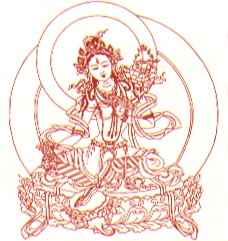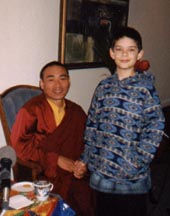
TeachingsScroll down the page or click on any of the following links:
Khentrul Lodro Thaye on Bodhichitta and Practice 10/25/03 Minneapolis (notes from) That which changes our mind is the method, all spiritual paths/religions. The method protects us from negative actions or karma. All religions have the same goal of ultimate happiness. There is only a difference in application; some are more effective. In Tibetan Buddhism the best and fastest path is gradual. Even a scattered practice can have benefit. But it is best to follow an order of practice. It is important to get the key points. PART I - First develop authentic, pure motivation. This is the foundation. Also meet with qualified spiritual friend (teacher). They can help you throughout the path. Continue to train in the four thoughts. Continue to work on bodhichitta. The key points on meditating on Bodhichitta will follow. Meditate on the emptiness of all phenomena. Understand emptiness well. Understand our Buddha nature, our own true nature and the cause of our own enlightenment. How is the Buddha nature in us? Ask the teacher. The teacher has special insight into unity and calm abiding. The teacher is the basis for tantric practice. You only need one diety practice done well. Maha yoga is engaging in diety visualization and mantra. Ani yoga works on the subtle channels. We need to develop timeless awareness of our own true nature. Our mind goes 100% change. The teacher does pointing out instruction with us. Need to do all this before higher practice. Need to do the ngondro short practice. All the key points are in 4-5 pages. It is very important to come to an understanding. Shinatta and vispassana practice takes 2-3 pages. Hear the teachings, contemplate, and practice. With Dzogchen the teacher with one word or one gesture, one moment when you are ready, will cause your understanding and enable you to see your own nature. There will be rejoicing with knowing. Dharma is practiced through intellectual questioning and understanding. The three excellencies – the method to insure perfection
Excellence is embraced by skillful means. It is the motivation behind action. It is best to apply the three excellencies to any practice. Enlightened intention is bodhicitta. For enlightened attitude you need to develop Bodhicitta. These conditions are the flower: Bodhicitta is the beginning or the seed; the middle is the heat and soil; the end is the flower in full bloom. Develop Bodhicitta so it becomes your experience. Bodhicitta is two fold. First see the suffering in all sentient beings. A compassionate wish is not enough. You need to wish that they reach complete freedom, that is Buddhahood or enlightment or the great perfection of wisdom. We develop this through training, until it becomes our continual experience. We need to develop this to the best of our ability. Pretend until it becomes our experience. Enlightenment only comes with Bodhicitta. The entire path and enlightenment has Bodhicitta at our core. Before prostration or any practice, cultivate Bohicitta. The three virtuous motivations:
Analytical mind training Primarily looks at motivation. To create the causes for happiness by virtue. Negative intentions and actions, such as anger towards others, are adverse to our own happiness. Negative intention hurts others and ourselves. Need to reverse the mind, look out and benefit others. Turn the mind inside out. We’ve been searching for happiness. We’ve mistaken the path. Change to the honest path; get rid of the degenerate path through practicing the Four Immeasureables: equanimity, loving kindness, compassion, and joy. Equanimity for all sentient beings. All beings have attachments and aversions/anger in their mindstream . We have attachment to our family and anger towards others. This is our bias. We need to loose this. It is a very narrow scope. We need to see that all beings have this bias. “May all beings be free of attachments and aversions.” Meditate on this, cultivate this again and again. Start with one person, recognize they have a bias. Say:
Loving kindness for all sentient beings who have not found happiness. May all sentient beings find happiness. Start with someone we love, make a wish for them. Then your whole family, your friends, and friends with no connection.
Compassion. Recognize that all sentient beings are suffering.
Joy is rejoicing in other’s happiness even though it may be temporary and brief.
Do one Immeasureable prayer a day. Work up to doing it for all beings without exception. We want a kind hearted attitude. This cannot be bought; not through bombs, quarrels, pain, terror, nor war. This is difficult. Think what if would be like if all beings cultivated this right at this moment. PART II – Main part, the non-referential middle, action, engagement Recognize grasping and fixating on all phenomena as real; this is a mistaken perception. All confusion arises here. The outer universe, beings, sensory experiences etc. are just like the universe in our dreams. The habitual patterns of the mind creat our daily experiences. This is an optical illusion like a reflection on water; not true existence. Study logic. Contemplate emptiness. Engage in virtuous activity. We hold to three spheres of self, others, and action. But, this does not exist. When doing prostrations, recognize emptiness. PART III – Dedicate the merit. Doing this for a gathering of wealth/merit in the future. We make it inexhaustible by giving it to others. Merit is illusory, beings are illusory.
Example: Imagine you say mantras. Notes from Khentrul Lodro Thaye's Teaching on Calm Abiding Meditation 10/24/03 All dharma helps us all. Khentrul Lodro Thaye Rinpoche spent twenty years studying at Mardo Tashi Choling and Katok monasteries in Eastern Tibet, Khenchen Jigme Phuntsok's Serthar Buddhist Institute in Kardze, Tibet, and Penor Rinpoche's monastery Namdroling in India. Acknowledged as a scholar of the highest level (khenchen), he twice received the title of khenpo (equivalent to Doctor of Philosophy). In addition to having completed the traditional three-year retreat, he has received the entire Nyingtik lineage (including Nyingtik Yabzhi, Dzod Dun, Ngalso Korsum, Yeshe Lama, and Chetzun Nyingtik) as well as many other empowerments, scriptural transmissions, and explanations on the pith instructions for Great Perfection practice (dzogchen). Khentrul Rinpoche has also received the rarely bestowed oral transmission of Khenpo Ngakchung's Nyingtik lineage. From Jigme Phuntsok Rinpoche, Dodrubchen Rinpoche, Penor Rinpoche, and Katok Moktza Rinpoche, he has received all of the empowerments and scriptural transmissions for the Kama and Terma cycles of the Nyingma school. He has taught for many years at monasteries in Tibet and India and is the abbot of Mardo Tashi Choling where he has established a retreat center and shedra (Buddhist college). He directs the education and spiritual practice of three hundred monks, of whom there are seventy advanced-degree candidates, sixty children, and twenty retreatants. |


